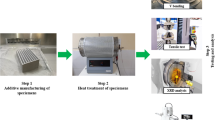Abstract
The characteristics of temperature change on die and billet are very complex during the deformation process because of the interaction between them and some unstable external factors. In this paper, the numerical simulation model for the crank shaft die forging was established by means of the rigid-plastic FEM method. The model was validated by optical non-contact 3D measurement—ATOS. Based on available research results, this paper explored the effect of temperature conditions on material deformation and die wear. Three parameters, press velocity and initial temperature of billet and die, were chosen to illustrate the effects. From the experimental results, the effect of process parameters on deformation ability of the material is simple, while the effect on die wear is relatively complicated. The press velocity plays an important role on die wear when the initial temperature of the billet has larger influence on material deformation. A conclusion can be drawn that when the initial temperature of the billet is 1100 °C, the initial temperature of the die is 250 °C, and the velocity is kept in the range of 200-300 mm/s, the optimum solution for deformation ability of the material and die wear can be obtained. It is possible for the conclusion to be extended further for the control of temperature condition to optimize die life and material deformation.
















Similar content being viewed by others

References
O. Brucelle and G. Bernhart, Methodology for Service Life Increase of Hot Forging Tools, J. Mater. Process. Technol., 1999, 87(1-3), p 237–246
T. Iwama and Y. Morimoto, Die Life and Lubrication in Warm Forging, J. Mater. Process. Technol., 1997, 71(1), p 43–48
R.S, Lee, and J.L. Jou, Application of Numerical Simulation for Wear Analysis of Warm Forging Die, J. Mater. Process. Technol., 2003, 140(1-3), p 43–48
L.V. Cheng, L. Zhang, Z. Mua, Q. Tai, and Q. Zheng, 3D FEM Simulation of the Multi-stage Forging Process of a Gas Turbine Compressor Blade, J. Mater. Process. Technol., 2008, 198(1-3), p 463–470
U.S. Dixit, S.N. Joshi, and J.P. Davim, Incorporation of Material Behavior in Modeling of Metal Forming and Machining Processes: A Review, Mater. Des., 2011, 32(7), p 3655–3670
P. Hartley and I. Pillinger, Numerical Simulation of the Forging Process, Comput. Methods Appl. Mech., 2006, 195(48-49), p 6676–6690
D.H. Kim et al., Die Life Considering the Deviation of the Preheating Billet Temperature in Hot Forging Process, Finite Elements Anal. Des., 2005, 41(13), p 1255–1256
A. Minami, Y. Marumo, H. Saiki, L. Ruan, and O. Shizuma, Effects of Simulation Conditions on Evaluation of Tool Temperature in Hot Extrusion-Forging, J. Mater. Process. Technol., 2006, 177(1-3), p 251–255
W. Huachang, W. Guan, X. Han, and W. Hongfu, Hot-forging Die Cavity Surface Layer Temperature Gradient Distribution and Determinant, J. Wuhan. Univ. Technol., 2011, 26(4), p 801–806
C. Cosenz, L. Fratini, A. Pasta, and F. Micari, Damage and Fracture Study of Cold Extrusion Dies, Eng. Fract. Mech., 2004, 71(7-8), p 1021–1033
M.W. Fu, J. Lu, and W.L. Chan, Die Fatigue Life Improvement Through the Rational Design of Metal-Forming System, J. Mater. Process. Technol., 2009, 209(2), p 1074–1084
P. Skov-Hansen, N. Bay, J. Grùnbñk, and P. Brùndsted, Fatigue in Cold-Forging Dies: Tool Life Analysis, J. Mater. Process. Technol., 1999, 95(1-3), p 40–48
S.A. McKinley and A. Fatemi, Surface Finish Effect on Fatigue Behavior of Forged Steel, Int. J. Fatigue, 2012, 36(1), p 130–145
H.M.T. Khaleed and Z. Samad, Work-Piece Optimization and Thermal Analysis for Flash-Less Cold Forging of AUV Propeller Hubs—FEM Simulation and Experiment, J. Manuf. Process., 2011, 13(1), p 41–49
J.H. Kang, I.W. Park et al., A Study on a Die Wear Model Considering Thermal Softening: (I) Application of the Suggested Wear Model, J. Mater. Process. Technol., 1999, 96(1-3), p 183–188
D. Heinemeyer, Untersuchungen zur Frage der Haltbarkeit von Schmiedegesenken, Dr.-Ing. Thesis, Hannover, 1976
K. Lange, L. Cser, M. Geiger, and J.A.G. Kals, Tool Life and Tool Quality in Bulk Metal Forming, CIRP Ann. Manuf. Technol., 1992, 41(2), p 667–675
T. Hisakado, Effects of Surface Roughness and Surface Films on Contact Resistance, Wear, 1977, 44(2), p 345–359
P.H. Hansen and N. Bay, A Flexible Computer based System for Prediction of Wear Distribution in Forming Tools, Adv. Technol. Plast., 1990, 1, p 19–26
E. Summerville, K. Venkatesan, and C. Subramanian, Wear Processes in Hot Forging Press Tools, Mater. Des., 1995, 16(5), p 289–294
P.K. Saha, Thermodynamics and Tribology in Aluminum Extrusion, Wear, 1998, 218(2), p 179–190
Z. Gronostajski and M. Hawryluk, The Main Aspects of Precision Forging, Arch. Civ. Mecheng., 2008, 8(22), p 39–55
Author information
Authors and Affiliations
Corresponding author
Rights and permissions
About this article
Cite this article
Zhi, J., Jie, Z., Jin-jin, J. et al. The Effect of Temperature Condition on Material Deformation and Die Wear. J. of Materi Eng and Perform 22, 2019–2028 (2013). https://doi.org/10.1007/s11665-013-0489-z
Received:
Revised:
Published:
Issue Date:
DOI: https://doi.org/10.1007/s11665-013-0489-z



